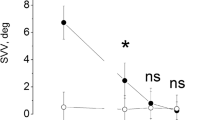Abstract
Static and dynamic otolith, horizontal vestibular and optokinetic ocular reflexes were investigated in pigmented rats 1–6 and more months after unilateral vestibular nerve (UVN) section. Evoked responses were compared with published data from control rats studied under identical conditions. Static lateral tilt of UVN rats in the light evoked a vertical deviation in static eye position that was as large as in controls. In darkness, the evoked responses in UVN rats 6 months after the lesion were consistently smaller than in controls. Linear horizontal acceleration in darkness evoked vertical and torsional response components in UVN rats that were parallel-shifted towards lower gains and larger phase lags. Off-vertical axis rotation on a platform provoked responses that differed markedly from those recorded in intact rats with respect to the bias velocity component. These results suggest a permanent deficiency in the static and dynamic otolith-ocular reflex performance of UVN rats. Ocular responses to horizontal table velocity steps in darkness exhibited a direction-specific asymmetry in UVN rats. Step responses evoked by acceleration towards the intact side were larger in gain and longer in duration than responses evoked by acceleration towards the operated side. When compared with control data, responses to either side were reduced in UVN rats and the velocity store mechanism was barely activated by velocity steps towards the operated side. Responses evoked by horizontal optokinetic stimulation with constant pattern velocities were below control values in either direction. Slow-phase eye velocity saturated at much lower values than in intact rats, particularly during pattern motion towards the intact side. The duration of the optokinetic afternystagmus was asymmetrically reduced with respect to control data. Practically identical reductions in duration were found for vestibulo-ocular responses in the opposite directions. Behaving animals exhibited no obvious impairment in their spontaneous locomotory or exploratory activities. However, each UVN rat was impaired, even 2 years after the lesion, in its postural reaction to being lifted by the tail in the air. This observation suggests the presence of a permanent deficit in static and dynamic otolith-spinal reflexes that may be substituted on the ground by proprioceptive inputs.
Similar content being viewed by others
Author information
Authors and Affiliations
Additional information
Received: 26 February 1997 / Accepted: 2 July 1997
Rights and permissions
About this article
Cite this article
Hamann, K., Reber, A., Hess, B. et al. Long-term deficits in otolith, canal and optokinetic ocular reflexes of pigmented rats after unilateral vestibular nerve section. Exp Brain Res 118, 331–340 (1998). https://doi.org/10.1007/s002210050287
Issue Date:
DOI: https://doi.org/10.1007/s002210050287




